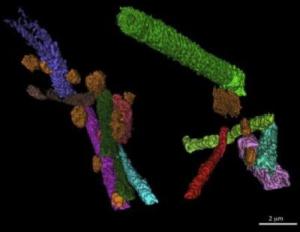Tiny 1,900 million-year-old fossils from rocks around Lake Superior, Canada, give the first ever snapshot of organisms eating each other and suggest what the ancient Earth would have smelled like.
The fossils, preserved in Gunflint chert, capture ancient microbes in the act of feasting on a cyanobacterium-like fossil called Gunflintia — with the perforated sheaths of Gunflintia being the discarded leftovers of this early meal.
A team, led by Dr David Wacey of the University of Western Australia and Bergen University, Norway, and Professor Martin Brasier of Oxford University, reports in this week’s Proceedings of the National Academy of Sciences the fossil evidence for how this type of feeding on organic matter — called ‘heterotrophy’ — was taking place. They also show that the ancient microbes appeared to prefer to snack on Gunflintia as a ‘tasty morsel’ in preference to another bacterium (Huroniospora).

A 3D reconstruction of tubular Gunflintia fossils being eaten by heterotrophic bacteria (orange spheres and rod-shapes) gives the first ever snapshot of organisms eating each other, Oxford University and University of Western Australia scientists report. (Credit: David Wacey)
‘What we call ‘heterotrophy’ is the same thing we do after dinner as the bacteria in our gut break down organic matter,’ said Professor Martin Brasier of Oxford University’s Department of Earth Sciences, an author of the paper. ‘Whilst there is chemical evidence suggesting that this mode of feeding dates back 3,500 million years, in this study for the first time we identify how it was happening and ‘who was eating who’. In fact we’ve all experienced modern bacteria feeding in this way as that’s where that ‘rotten egg’ whiff of hydrogen sulfide comes from in a blocked drain. So, rather surprisingly, we can say that life on earth 1,900 million years ago would have smelled a lot like rotten eggs.’
The team analysed the microscopic fossils, ranging from about 3-15 microns in diameter, using a battery of new techniques and found that one species — a tubular form thought to be the outer sheath of Gunflintia — was more perforated after death than other kinds, consistent with them having been eaten by bacteria.
In some places many of the tiny fossils had been partially or entirely replaced with iron sulfide (‘fool’s gold’) a waste product of heterotrophic sulfate-reducing bacteria that is also a highly visible marker. The team also found that these Gunflintia fossils carried clusters of even smaller (c.1 micron) spherical and rod-shaped bacteria that were seemingly in the process of consuming their hosts.
Dr Wacey said that: ‘recent geochemical analyses have shown that the sulfur-based activities of bacteria can likely be traced back to 3,500 million years or so — a finding reported by our group in Nature Geoscience in 2011. Whilst the Gunflint fossils are only about half as old, they confirm that such bacteria were indeed flourishing by 1,900 million years ago. And that they were also highly particular about what they chose to eat.’



 April 30th, 2013
April 30th, 2013  Riffin
Riffin  Posted in
Posted in  Tags:
Tags: 